Brown proposes to cut $400 million for community colleges and raise student fees by almost 40%
More cuts to come if voters don’t support extending tax increases
by Masao Suzuki, Skyline, AFT 1493 Executive Committee Co-Rep.
Governor Brown is proposing to cut state funding for community college by $400 million for next year (July 2011 to June 2012) as part of cutting $12 billion from the California state budget. The San Mateo Community College District gets about 2% of the total community college funding, so this would be about an $8 million dollar cut to the district.
Brown is also proposing to raise community college student fees from $26 to $36 per unit, or almost 40%. This will raise about $110 million that will partially offset the $400 million cut he proposed. Taken together the community colleges will be getting about $300 million less and community college students will be paying $100 million more. This would mean a total cut of about $6 million in funding to our district.
In addition, Brown is continuing the practice of “deferrals” which means that the state puts off giving money they promise schools. This pushes payments to the following fiscal year, making the current year’s expenses look like less. This forces school districts to borrow money and pay interest to tide them over until the money comes. Another proposal in the new budget is to change the census date for enrollment counts to the end of the semester, which would reduce enrollment because of students withdrawing during the semester.
The proposed budget would cut an additional $500 million from the CSU and UC systems each or about 18% of current state funding. This will mean higher fees, more out-of-state students, and fewer in-state students, making it harder to transfer and harder to graduate from a CSU or UC.
The worst proposed cuts are for programs serving lower-income individuals and households. MediCal (health insurance for low-income households) is proposed to take a $1.7 billion cut, or about 14% of current funding. CalWorks (California’s TANF or welfare) would be cut $1.5 billion, or a 25% cut. IHSS (in-home support services), which helps to keep low-income seniors and disabled in their homes and out of institutions, would be cut $500 million or almost 40%. Childcare funding would be cut $700 million or 45%! These cuts would directly impact childcare and other services on our campuses getting funds from these programs.
Brown did not cut the K-12 budget, which has already seen big cuts in past years. He is hoping that the threat of big cuts to K-12 will help pass his proposal to raise $12 billion by extending the higher income, sales, and car taxes passed two years ago for another five years.
Brown’s proposed tax extension is regressive, with the burden on low-income households about twice that on high-income households. But if the proposals are not passed, cuts to community colleges could increase to $500 million under Prop 98 and could rise to $700 million if Prop 98 is suspended (this is assuming across the board cuts to balance the budget). This would mean a $9 to $13 million cut to the district. However, the district would then be able to go to “basic aid” (relying on local property taxes instead of state funding), limiting the cut to about $8 million.
Negotiations Update
Your AFT Negotiating Team and the District Team have been meeting with a state appointed mediator in “unofficial mediation” to see if we can reach a settlement and avert going to Impasse. We’ve had several lengthy sessions, two at the end of the fall semester and one a couple of weeks into the spring semester. Due to the confidentiality of these sessions, we cannot report any specific details at this time. Our team is working hard to represent your interests, both full and part time faculty. We will give you a complete report as soon as we possibly can. Meanwhile, if you experience anything that you believe is contrary to the union contract language or that you have serious concerns or questions about, please contact one of the AFT Grievance Officers and your local reps. (See page 2 for names and contact information.)
In Unity,
Joaquin Rivera, Chief Negotiator
Katharine Harer
Victoria Clinton
Sandra Raeber Dorsett
Part-timers approve disability insurance
The implementation of California State Disability Insurance (SDI) for all part time faculty was approved by 73.68% of those who voted in the December election. Accordingly, the district will begin deducting for SDI as soon as it is approved by the state–probably in April, but we will let you know when it is set. For the latest information on SDI contribution rates, see: http://www.edd.ca.gov/disability/SDI_Contribution_Rates.htm
President’s Letter
We all want to improve student success rates, but faculty’s role is only a part of the picture
by Monica Malamud, AFT 1493 President
A defining characteristic of community colleges is that they provide access to a post-secondary education to anyone who can benefit from it. I am a firm believer that everyone deserves an opportunity to pursue a college education, and this is what drew me to look for a job at a community college, after having taught at some very prestigious, but selective and expensive, private universities. Teaching at those universities was an easy job: almost without exception, students were highly motivated, exceptionally smart, academically well-prepared and willing to do whatever it took to obtain an internationally recognized university diploma. All this, combined with the fact that their parents were good role models as successful professionals and they had high expectations of their children, translated into excellent graduation rates for these students. In other words, the privileged few that gain access to these universities are almost “predestined” to succeed.
What about all the students who don’t have the money, top grades and test scores to enter those universities? Many more students, not just those with the highest GPAs in their high school graduating class, can benefit from a post-secondary education. Many more students, not just those from families who have exceptionally high incomes, should be able to obtain a college degree. Community colleges provide access to higher education for a large segment of the population; for example, more than 70% of undergraduates in public colleges in California attend a community college.
Providing access to higher education means that the entry door is open. This is important, but not enough: we must also make sure that students can find the right exit doors from the community college—the ones that lead them to success (reaching their educational goals, earning a degree or certificate or transferring to a 4-year institution).
Preoccupied with student success
Lately, there has been increased emphasis and preoccupation with student success. There are all sorts of grants, initiatives, task forces, reports, foundations and organizations focused on student success. President Obama’s goal is that the United States achieve the highest proportion of college graduates in the world by 2020. According to 2007 data from the Organisation for Economic Co-operation and Development, about 40% of 25-34-year-olds in the US are college graduates; for comparison, among the 36 countries listed in this study, Canada had the highest percentage (55%) and Australia, Belgium, France, Ireland, Israel, Japan, Korea, New Zealand, Norway and Russia were higher than the US in this metric. [1]
At the state level, the Board of Governors of the California Community Colleges appointed members to a Student Success Task Force in January. There is also a joint task force of the California Community Colleges and the CSUs which is charged with the implementation of SB 1440, the Student Transfer Achievement Act.
In our district, I have noticed a stronger focus on student success too. Student success is frequently a discussion topic in departments, divisions, committees and councils. Faculty welcome the opportunity to discuss such an important topic, which is so central to our jobs as educators. After all, don’t we all want our students to be successful?
Educational and other factors affect student success rates
However, I would warn everybody to keep in mind that while what faculty do in the classroom certainly contributes to student success, it is in no way the sole factor. Student success is the result of an aggregate of factors that interact in very complex ways. Some factors are educational in nature, but others are not. Among the educational factors, the classroom component is just one of them, others being academic preparation, availability of academic support services and study habits of the student to name a few.
Some examples of non-educational factors that influence student success are time devoted to other responsibilities (such as work and family), availability and reliability of care for students’ young children and transportation. There are many other factors that may influence student success. Some of these factors have been known for a while, others I’m just now hearing about. The first recommendation of the 2020 Vision report of the Community College League of California (CCLC) states that “visible, high-level leadership across districts and colleges is essential for student success.” [2] If visibility of leaders is essential, then students will not succeed unless the college president and other college leaders walk around the campus or visit classes on a regular basis. I’m eager to read the research that supports the statement of causality of the CCLC.
Demographic changes could bump up student success rates
The measurement of student success could also be impacted if the budget cuts change the numbers and demographics of community college students. As budget cuts and increased fees lead to fewer students and more competition for the reduced number of classes, it is likely that academically underprepared and economically disadvantaged students will be left out of the system at significantly higher percentages, while better prepared students, who are more savvy in navigating the educational system (especially those who are bumped down from CSUs or UCs) take their places. This demographic shift is likely to lead to greater measured “student success,” but not because instruction is necessarily improving; instead student success would improve because we would be teaching increasing numbers of highly performing students. That’s not something to celebrate.
It is my hope that, with all of the time and resources spent on trying to figure out what really makes a difference in student success and how to measure it, we will either be able to figure out how to improve student success or to find out why success rates have remained flat over the years. This will require that we collect relevant data and focus on what matters and what we can realistically have an impact on.
Student success rates do not equal quality of instruction
Until then, measures of student success should be interpreted as what they are: indicators of how well students are doing. With the increased pressure for accountability, there is a risk that only the most obvious person is considered responsible for student success—the classroom teacher. While faculty’s role in student success is an important one, many others also need to be held accountable for the results.
[1] OECD Factbook 2010: Economic, Environmental and Social Statistics. OECD 2010.
[2] 2020 Vision: A Report of the Commission on the Future of the Community College League of California.
Margaret Hanzimanolis is named new AFT 1493 Part-Time Faculty Organizer
As part of its ongoing effort to involve more part-time faculty in the Union and to improve the working conditions for all faculty, the AFT 1493 Executive Committee has appointed Margaret Hanzimanolis as the Part-Time Faculty Organizer. As PTFO, Margaret will communicate with part-time faculty about their rights on the job and matters of interest to adjuncts, advocate for them, and serve as a liaison both with the leadership of our union local, and with part-timers in other locals of the California Federation of Teachers.
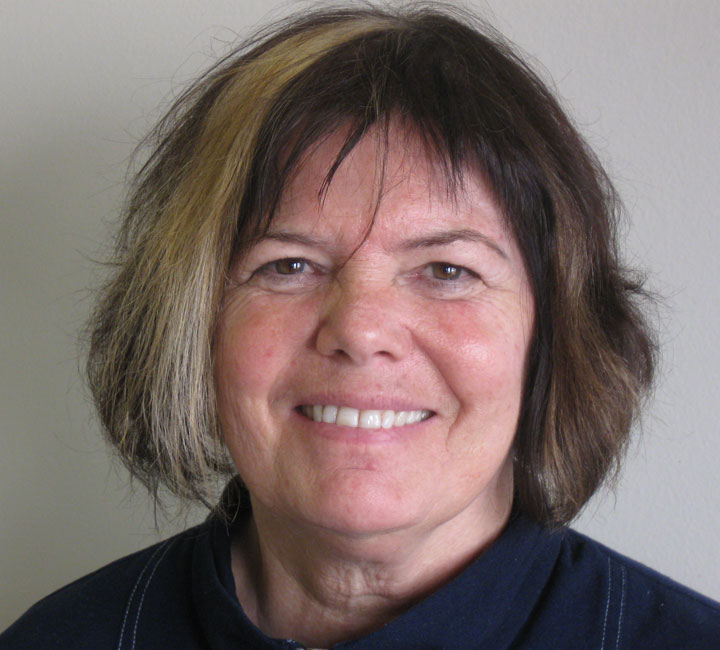
Margaret is a recent transplant, from Vermont, where she taught writing and literature at Johnson State College. While there, she served as the chief negotiator for the part-time faculty contract for the Vermont State Colleges (2007-2010) and is a veteran of three additional contract negotiations. She sat on the regional labor council in Vermont, as the statewide educational representative, and was elected Secretary of the Vermont State Colleges Delegate Assembly, a governing body for both full-time and part-time faculty. She has been appointed to the Modern Language Associations Committee on Community Colleges (2009-2011), elected to the executive committee on part-time labor (2010-2014), and put forward three resolutions on academic workforce staffing on behalf of the Radical Caucus of the MLA (2007, 2008, 2009), of which she is a steering committee member. She has done advocacy work at the national, state and local level, including testifying several times in Vermont state legislative hearings.
Margaret’s graduate work was done at the University of Alabama (MFA, Poetry) and the University of Cape Town (Ph.D., southern African colonial literature). She has taught in Argentina, South Africa, England, Vermont, Alabama, and California, in teen parent programs, graduate programs, adult degree programs, and conventional undergraduate programs. An accomplished builder, she has also designed, built, or renovated five houses, and can wire, plumb, do carpentry, masonry and even replace head gaskets on ailing Datsuns (or could at one time!) She’s worked in the field hoeing pumpkins with Jamaican laborers, weeding ginseng with teenagers, and leading a seminar at Oxford University. She is looking forward very much to working on behalf of the SMCCD part time faculty. She hopes to be of assistance in fostering greater inclusiveness of part-time faculty in the life of the colleges, greater familiarity of part-time faculty with their contract, more robust union participation at all levels, and a higher-profile recognition of the contributions of the almost 800 part-time faculty to the SMCCD.
Introducing Mike Noonan, Cañada’s new AFT 1493 Executive Committee Rep.
Mike Noonan has been Cañada College’s AFT 1493 Executive Committee Representative since the beginning of last semester. As a new member of AFT’s leadership body, we asked him to introduce himself to Advocate readers. –ed.
I was born in Michigan, but raised in the Bay Area. I’m a long-time student of history and have recently begun the frantic life of an adjunct. I have also been a long-time activist. It’s no accident that my field of study in college and graduate school was the Middle East. I began my undergraduate studies in 2003 at UC Berkeley when the war against the people of Iraq was started by the U.S. I continued my studies with a masters’ degree in world history at San Francisco State University, likewise with a focus on the Middle East. Today I teach Middle East History at Cañada College, and American and World History at Berkeley City College.
 I have been an activist the whole way through. I have been fighting for community colleges since 2003 when, as a student in the Peralta District I organized with 10,000 other community college students to march on Sacramento against Governor Gray Davis’ budget cuts. Community college was for me the bridge between high school and discovering my future studies in history. Community college is a safe place for young people who are out of step with the education system, or working their way up from a position of disadvantage towards a higher education. I have seen this story play out in my own life, in the lives of my friends, and now in the lives of my students. For these reasons I feel loyal to, and want to fight for the interests of the community college system, its students and its staff.
I have been an activist the whole way through. I have been fighting for community colleges since 2003 when, as a student in the Peralta District I organized with 10,000 other community college students to march on Sacramento against Governor Gray Davis’ budget cuts. Community college was for me the bridge between high school and discovering my future studies in history. Community college is a safe place for young people who are out of step with the education system, or working their way up from a position of disadvantage towards a higher education. I have seen this story play out in my own life, in the lives of my friends, and now in the lives of my students. For these reasons I feel loyal to, and want to fight for the interests of the community college system, its students and its staff.
Last year with teachers and students in other community colleges I worked to build the March 4 demonstration against the budget cuts in San Francisco. I was part of the Against Cuts grouping (Againstcuts.Org), organized by teachers and students to spread awareness and opposition to the budget cuts on a grass roots level. We undertook to organize as many people as possible on as broad a basis as possible to oppose the budget cuts. We put out information packets, t-shirts, buttons, and flyers, which anyone could use in and around their school or workplace. We organized teach-ins at Berkeley City College which drew in people from many nearby schools at all levels of education. We showed that community colleges could be the hub of the wheel in the fightback against the budget cuts. I look forward to continuing the fight as part of AFT 1493, bringing my activist experience along with the perspective of being an adjunct in the SMCCD.
Local History
History of the Progressive Movement in San Mateo
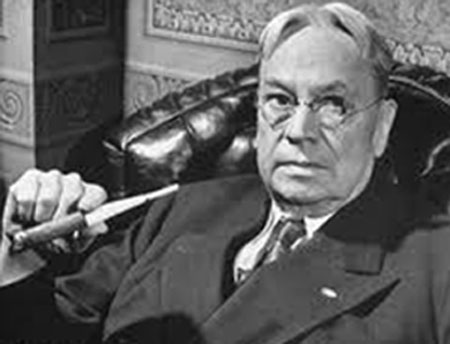 Very quietly, the 100th anniversary of the great triumph of the Progressive Movement in California passes us by. In November of 1910, Californians ushered in significant change with the election of Hiram Johnson as governor. Almost immediately the initiative, referendum and recall became part of the political life of the state. Open primaries replaced the backroom deals of the past, and, within one year, women gained the right to vote.
Very quietly, the 100th anniversary of the great triumph of the Progressive Movement in California passes us by. In November of 1910, Californians ushered in significant change with the election of Hiram Johnson as governor. Almost immediately the initiative, referendum and recall became part of the political life of the state. Open primaries replaced the backroom deals of the past, and, within one year, women gained the right to vote.
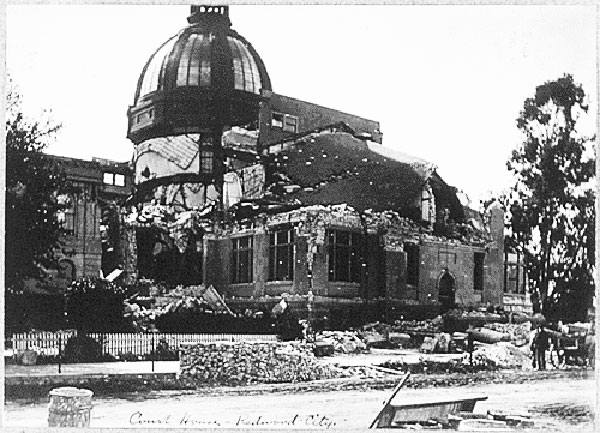 Change was not all that apparent locally. In San Mateo County the big story was the rebuilding of the courthouse in Redwood City which had been destroyed in the San Francisco Earthquake of 1906. Initial estimates allowed the Board of Supervisors to allocate $125,000 for the project. However, the new construction ended up costing $500,000. It seemed to people of the Peninsula that it was business as usual, as far as local politics were concerned.
Change was not all that apparent locally. In San Mateo County the big story was the rebuilding of the courthouse in Redwood City which had been destroyed in the San Francisco Earthquake of 1906. Initial estimates allowed the Board of Supervisors to allocate $125,000 for the project. However, the new construction ended up costing $500,000. It seemed to people of the Peninsula that it was business as usual, as far as local politics were concerned.
Nevertheless, progressivism would make an impression. In San Francisco a movement to unite the Bay Area into a Greater San Francisco was initiated by civic leaders impressed by the borough system of government formed in New York City. As Manhattan, Staten Island, Brooklyn, Queens and the Bronx had come together to create a great city, they felt that San Francisco, Marin County, San Mateo County and the East Bay should do so. There could be great efficiencies in government, more capital to create large public projects, such as bridges, roads and harbors, and the Bay Area would gain the ability to compete with emerging Los Angeles in the race for being the leading city of the West Coast.
 By 1912, leaders in San Mateo and Marin counties were tending to favor annexation. However, East Bay cities opposed it, and the Greater San Francisco plan went away for two years. When the proposal resurfaced in 1914, it was supported by the San Mateo Times. East Bay opponents again derailed the effort. Starting in 1916, San Francisco leaders began focusing on just annexing San Mateo County. San Francisco Mayor James “Sunny Jim” Rolph met with Peninsula leaders and received an enthusiastic response. Opposition from Hillsborough and Burlingame stalled progress, and then World War I put the issue on hold.
By 1912, leaders in San Mateo and Marin counties were tending to favor annexation. However, East Bay cities opposed it, and the Greater San Francisco plan went away for two years. When the proposal resurfaced in 1914, it was supported by the San Mateo Times. East Bay opponents again derailed the effort. Starting in 1916, San Francisco leaders began focusing on just annexing San Mateo County. San Francisco Mayor James “Sunny Jim” Rolph met with Peninsula leaders and received an enthusiastic response. Opposition from Hillsborough and Burlingame stalled progress, and then World War I put the issue on hold.
In 1923, business leaders of San Mateo County started up the discussion once more. Through their Three Cities Chamber of Commerce (Burlingame, San Mateo and Hillsborough) they met with the San Francisco Chamber of Commerce. They proposed a more modest plan that
would annex the Peninsula only as far down as Belmont on the Bayside and Half Moon Bay on the Coast. Once again conservative voices from the mid-county put a stop to the discussions.
However, in 1927, the most ambitious attempt yet was launched by the San Francisco Chamber. It commissioned a San Francisco Bureau of Government to create a massive study of the two counties to determine the pluses and minuses of annexation. The San Francisco – – San Mateo Survey was published in 1928 and, showing overwhelming positive evidence, favored annexation. A furious debate in San Mateo County ensued for four years. The on-set of the Great Depression in 1929 eventually did-in the annexationists. As times got bad, the local press, in San Francisco and down the Peninsula, focused on political waste and corruption in the City. This gave fuel to the anti-annexation camp.
In the meantime, those progressively minded on the Peninsula became more involved with an effort to create a new charter for San Mateo County that would allow for a county manager type government. That movement gained momentum as the old-time political clique of the Peninsula favored a charter change over becoming part of San Francisco. Local politicians reasoned that with a county manager system at least they would be able to maintain some control; so they threw the new charter to the Progressives as a bone.
In November of 1932, as Americans were deciding to vote Franklin Roosevelt into office, the people of San Mateo County voted in favor of a new charter. Annexation was never again brought up seriously on the Peninsula.
Come to the San Mateo County History Museum after February 17, 2011 and see our new display on “Broads, Bookies and Bootleggers” which describes some of this era through engaging new exhibits.
In Memoriam
David Noble: teacher, author, educational activist
By Greg Davis, CSM, emiritus
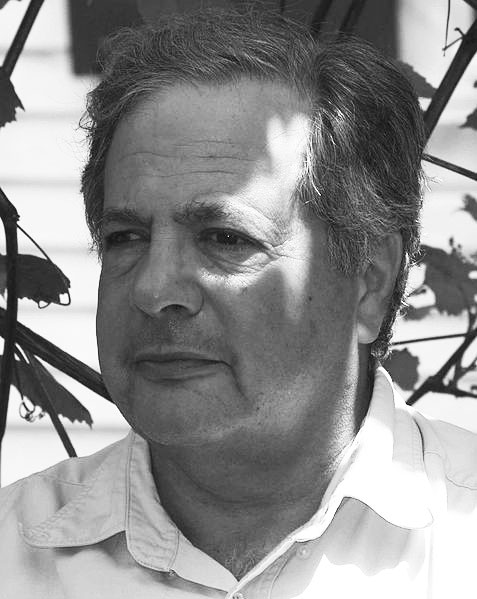 Dr. David Noble, Professor of History at York University (Toronto), died in December at age 65. He also had taught at MIT, Harvey Mudd College, and Drexel University; was a co-founder, with Ralph Nader, of the National Coalition for Universities in the Public Interest (1983); and had served as curator of modern technology at the Smithsonian Institution. He wrote a number of illuminating books, including America by Design: Science, Technology, and the Rise of American Capitalism (1977), The Religion of Technology (1997), and Digital Diploma Mills (2001).
Dr. David Noble, Professor of History at York University (Toronto), died in December at age 65. He also had taught at MIT, Harvey Mudd College, and Drexel University; was a co-founder, with Ralph Nader, of the National Coalition for Universities in the Public Interest (1983); and had served as curator of modern technology at the Smithsonian Institution. He wrote a number of illuminating books, including America by Design: Science, Technology, and the Rise of American Capitalism (1977), The Religion of Technology (1997), and Digital Diploma Mills (2001).
Critic of corporatization of higher education
A historian of technology and a professor in North American universities, he was never-the-less a critic of both. His ideas ran contrary to the generally held beliefs that all technology was an unmitigated benefit and that whatever enhanced corporate profits would benefit America. Noble focused on several of the most important educational issues of our time, including computerized instruction in colleges and universities, the commodification of knowledge into commercially marketable products, and the infiltration and co-opting of higher education by private corporations- i.e., what he called a process of corporatization.
I met David Noble in 1998, after Dan Kaplan and I attended a lecture he gave at UC Berkeley on corporatization. The Chancellor of UCB had signed without faculty participation an agreement with Novartis, a for-profit biotech firm, according to which the University, in exchange for a $25 million investment in the Department of Natural Resources, gave it control over publication of research, commercial rights to all research, and the right to appoint several of its scientists to the Department’s faculty. Noble saw the agreement as a violation of a taxpayer-funded institution’s role to serve the public, not a private, interest; of its commitment to open debate and full disclosure of all research results; and of the traditional role of the faculty, not the administration, to make decisions within academic disciplines. Needless-to-say, UCB’s more recent $500 million agreement in 2007 with British Petroleum (of Deepwater Horizon oil spill notoriety, no less!) to create the Energy Biosciences Institute was even more controversial. It is an indication of how much further the process of corporatization has advanced at UCB since Noble’s 1998 cautionary talk.
In 1997, the evolving issue of computerized instruction had came to a head after the administration at UCLA, in partnership with a for-profit company, the Home Education Network, ordered all faculty to put their courses online without compensation and despite student opposition and a lack of faculty involvement in the decision. The same year, at York University (where Noble taught and organized the opposition), after a two-month, student-supported faculty strike, the administration was forced to abandon similar plans. And at California’s State University system, an unprecedented partnership (California Educational Technology Initiative) between CSU and a consortium of private corporations, GTE, Hughes, Fujitsu, and Microsoft, ultimately was abandoned due to faculty and student opposition, as well as that of corporate competitors Apple, Sun, and Netscape. In 1999, SMCCD’s AFT organized a statewide conference on community college faculty issues relating to computerized instruction, at which David Noble, who had already put on the Web some of the critique which eventually appeared in Digital Diploma Mills, was the featured speaker.
“Digital Diploma Mills” foresaw institutions like University of Phoenix
As outlined and explained in this analytical classic of the political economy of computerized instruction, Noble clearly saw it as part and parcel of the corporatization of higher education in North America. Back in 2001, when Mills was published, Noble had identified as vendors of online network hardware and software Microsoft, Apple, IBM, Bell, and edutainment publishing companies like Disney, Simon and Schuster, and Prentice-Hall. He also mentioned the explicit commercial intent of the Western Governors’ Virtual University Project and the existence of Educause, an academic-corporate consortium formed to standardize, computerize, and outsource to commercial vendors course design, lectures, and evaluation.
Thanks to Noble’s conscious-raising writings and activities and the inherent student distaste for a depersonalized and standardized learning format, computerized instruction in higher education has largely remained, except in profit-oriented educational institutions like Phoenix University, distance learning for a limited student clientele, including the elderly, disabled, full-schedule workers unable to attend college classes, and those with business and technology careers interested in upgrading their knowledge.
The push for online classes to cut costs continues
Today, however, the proponents in California of expanding community college online offerings to a more general student population as a cost-cutting measure, including the Legislative Analyst’s Office and UCB’s Center for Studies in Higher Education, are betting that budgetary desperation and concerns over training the jobless, plus a new generation of students conditioned by an information technology- saturated adolescence, will combine to provide a favorable reception to their proposals. The corporate effort to expand the community college market for information technology has likewise intensified, with non-profit organizations like the Bill and Melinda Gates Foundation, in the forefront. The Foundation’s “Completion by Design” and “New Generation Learning Challenges” grant programs are designed to establish a firm foothold for an information technology and business management reform agenda, initially aimed at disadvantaged student populations in community colleges.
David Noble’s presence on the North American education landscape will be sorely missed at this crucial time. He could have helped once again to inform the debate, clarify the issues, explain the factors of political economy which underlie the surface of the debate, and lead by example the fight to protect teachers’ rights as professionals and academic values. Since he is gone, however, we have no choice but to honor his legacy and continue the struggle on our own.
AFT 1493 Faculty Survey Results
District faculty respond to Advocate readership survey
by Eric Brenner, Advocate Editor
In December 2010, AFT 1493 conducted a brief online survey of our faculty’s views of the Advocate. 166 faculty–92 full-time faculty members, 66 adjunct faculty and 1 retiree–responded. 62 respondents (38%) reported that they “read every issue pretty thoroughly”, 60 (36%) said they “look at each issue and usually read a few articles”, 31 (19%) replied that they “occasionally read some articles from some issues”, 8 (5%) responded that “rarely read any Advocate articles” and 4 respondents (2%) said that they “never read the Advocate at all.”
Regarding what version of the Advocate faculty read, 130 (80%) respondents said that they read the print version delivered to departments, 64 (40%) read the online version of the Advocate by clicking on the link from our email announcement and 31 (19%) read the email version of the Advocate, by viewing the start of articles in the email and clicking to view more of articles they’re interested in. (Clearly, many faculty read the Advocate in multiple formats.)
When survey respondents were asked to identify topics about which they were most interested in reading, the top choice was “faculty contract and negotiations issues” (145 faculty, 88%), followed by “faculty grievances and faculty rights issues”(110 faculty, 66%), “district and state budget issues”(107 faculty, 65%), and “part-timer issues”(97 faculty, 59%).
How can the Advocate be improved?
The final survey question asked faculty what they thought we could do to improve the Advocate. 35 respondents said that they thought the newsletter was doing a fine job and didn’t need any changes. Some of the positive responses included: “The award winning Advocate is pretty perfect as is…don’t fix it if it ain’t broke!” and “I think the Advocate is just fine and has really improved over the years. Keep up the great work!” Several respondents (9) asked for more coverage of part-timer issues, some asked for more regular articles on understanding different aspects of the contract, and others suggested more pedagogical articles, more basic information for newcomers and more articles on “how SMCCCD compares and contrasts with other community college districts.” Some other individual suggestions included: “add some humor/cartoons,” “encourage new writers and contributors,” “shorten it, make it less dense” and “more of the truth of what’s going on.”
We greatly appreciate all of the feedback we received and we’d like to briefly respond to some of the above suggestions. More part-timer coverage is a priority, which will be led by AFT 1493’s new Part-Time Faculty Organizer, Margaret Hanzimanolis. (See the article on page 4.) In coming issues, we also plan to reinvigorate our occasional column, “Know Your Contract” as well as focusing more on information for newer faculty and on coverage of pedagogical issues. We will also work on providing more comparisons of our district with other districts, but for immediate data that compares salaries and other contract issues of districts throughout the state, go to the AFT 1493 website (aft1493.org) and click on “Other District Contracts” under the “Contract and Salaries” pull-down menu. There you will find links to the most recent statewide community college salary study, part-time/full-time salary comparisons from the California Part Time Faculty Association and links to almost every community college faculty contract and salary schedule in the state. We also definitely agree that we need some more humor and cartoons, and beginning in this issue, we will try to always have some of the lighter stuff. See the cartoon on page 3 (and let us know what you think.) As for making our issues shorter and less dense, this is (believe it or not) always one of our top goals. In fact, starting with the beginning of the 2010-11 academic year, we set a policy of no longer publishing any issues more than 8 pages and we are working on reducing text and increasing graphics in every issue. Finally, we are always committed to printing the truth and we always encourage new faculty contributors to submit articles and ideas on any issue related to college teaching, our district or our union.
Retirees
Joe Marchi discusses the American musical at DART December gathering
by John Searle, DART President
The District Association of Retired Teachers (DART) is alive and well, and kicking. Last December, the organization celebrated the holiday season with an afternoon enjoying, listening to (and questioning) Joe Marchi, who gave a scintillating presentation on the American musical.
As is customary, food and drinks were both provided and eagerly consumed.
The organization is trying to offer its members (and other interested faculty, both working and retired) a variety of talks and activities to stir both the grey matter and the body. With this idea at the forefront, courtesy of the effort of John Kirk, the next planned meeting will be a casual three-mile walk in the watershed area on Cahill Ridge, scheduled for a 10:00 a.m. start on Saturday, April 30th. The walk will be led by Tim Anderson, and the requirement is that committed hikers RSVP to John Kirk (at: Kirk@smccd.edu) supplying their name, and either a contact email or a contact phone number (presumably to identify potential mountain lion snacks).
Prospective walkers will meet at the north side of Highway 92 on Upper Skyline Boulevard just before the entrance to Skyline Cemetery at 10:00am. An optional extension to the occasion, for those interested, will be to have lunch at Bucks in Woodside, off Cañada Road.
One last matter of business: DART is looking for individuals to consider the unpaid, but worthwhile and necessary jobs of: a) treasurer, and b) secretary for the organization. Please contact John Searle at: Searle@smccd.edu if you are interested.
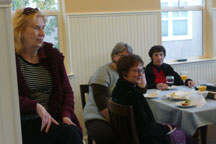

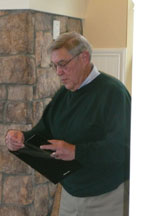
At the DART December gathering audience members enjoyed food and drink and listened to Joe Marchi (at right) discuss the American musical

